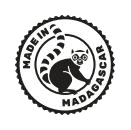The bright yellow sap found in the skin of aloe leaves contains a group of compounds referred to as anthraquinones (common in US) and as hydroxyanthracene derivatives (common in EU).

The Figure on the left is hydroxyanthracene and on the right is anthraquinone. Hydroxyanthracene can also be called dihydroxyanthraquinone. These Figures show the 3 ring base section of the molecules. Much like the ‘-OH’ groups attached to the rings, many molecular groups can possibly be added or removed at multiple ring locations.
Examples:

Aloin A & B are the major anthraquinones/hydroxyanthracenes found in Aloe macroclada. They are aloe-emodin with a glucose molecule attached in the place of a ‘=O’ on the central ring.
High levels of anthraquinones taken over long periods of time (used as a laxative) have been shown to cause colon cancer in rats. Low levels of aloin have been demonstrated to be safe when consumed over extended periods of time.
The concentration of aloin is typically expressed as parts per million (ppm = ug/g, microgram per gram) by weight. In other words, one molecule of aloin out of one million molecules is one part per million (roughly, need to adjust for weights of molecules).
The industry standard for expressing aloin ppm is as the original unconcentrated or undiluted gel. Therefore, if 1 milliliter of gel is concentrated to dryness, the aloin amount remains the same and the ppm description also stays the same.
An important point to make is the concentration (ppm) must always be considered with the amount. Consuming a small amount, such as 0.10g, containing 10ppm results in less aloin than consuming 10 grams with 1.0ppm aloin.
0.10g X 10 ug/g = 1ug compared to 10g X 1.0 ug/g = 10ug

